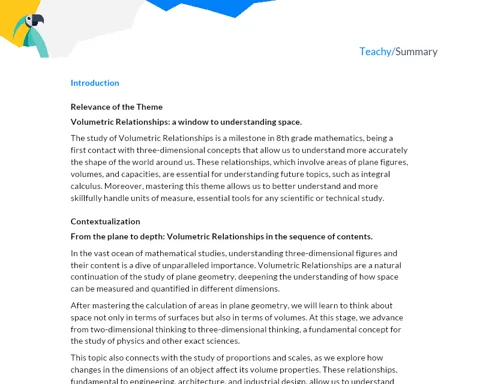Exploring the Geometry of Hexagons: From Theory to Practice
Objectives
1. Understand the definition and properties of a regular hexagon.
2. Learn the formula for calculating the area of a regular hexagon.
3. Apply knowledge of area calculation to practical problems.
Contextualization
Hexagons are fascinating geometric shapes that frequently appear in nature, such as in the honeycombs of bees, and in various human applications, such as floor and tile patterns. Understanding how to calculate the area of a hexagon is essential not only for solving mathematical problems but also for applying this knowledge in architectural, engineering, and interior design projects. For example, when designing a room with a hexagonal shape, knowing how to calculate its area is crucial to determining the amount of material needed for the flooring.
Relevance of the Theme
Understanding the calculation of the area of hexagons is crucial in today's context, as this skill has practical applications in various professions, such as architecture, engineering, and design. In addition, the hexagonal shape is efficient in terms of space and material usage, making it a popular choice in many construction and design projects. Mastering this knowledge prepares students to tackle real challenges in the job market.
Definition of Hexagon and Regular Hexagon
A hexagon is a polygon with six sides and six angles. A regular hexagon is a special type of hexagon where all sides and angles are equal. This symmetry makes the regular hexagon a geometric figure of great interest in both theoretical mathematics and practical applications.
-
A hexagon has six sides and six angles.
-
In a regular hexagon, all sides and angles are equal.
-
The symmetry of the regular hexagon facilitates the calculation of its area and other geometric properties.
Properties of Hexagons
Hexagons have several interesting properties. For example, the sum of the internal angles of a hexagon is always 720 degrees. In the case of a regular hexagon, each internal angle measures 120 degrees. Moreover, regular hexagons can be subdivided into six equilateral triangles, which makes calculating their area easier.
-
The sum of the internal angles of a hexagon is 720 degrees.
-
Each internal angle of a regular hexagon measures 120 degrees.
-
Regular hexagons can be subdivided into six equilateral triangles.
Formula for Calculating the Area of a Regular Hexagon
The formula for calculating the area of a regular hexagon is given by: Area = (3 * square root of 3 * side^2) / 2. This formula results from the sum of the areas of the six equilateral triangles that make up the regular hexagon. Knowing this formula allows solving practical problems that involve determining hexagonal areas.
-
The area formula is: Area = (3 * square root of 3 * side^2) / 2.
-
The formula derives from the sum of the areas of six equilateral triangles.
-
Using this formula facilitates solving practical problems involving hexagons.
Practical Applications
- In architecture, hexagons are used in the design of floor and roof patterns due to their spatial efficiency.
- In engineering, hexagonal structures are common in building materials because of their strength and efficient use of materials.
- In nature, honeycombs created by bees are hexagonal, allowing for efficient space and material usage.
Key Terms
-
Hexagon: A polygon with six sides and six angles.
-
Regular Hexagon: A hexagon in which all sides and angles are equal.
-
Area of Regular Hexagon: (3 * square root of 3 * side^2) / 2.
Questions
-
How can knowledge about hexagons be applied in your future profession?
-
What other geometric shapes do you think are important to understand beyond hexagons?
-
How can the efficiency of space usage in hexagons be applied in your everyday life?
Conclusion
To Reflect
Throughout this lesson, we explored the fascinating geometry of hexagons, learning to calculate their areas and understanding their numerous practical applications. Hexagons are not merely abstract mathematical shapes; they play a crucial role in various professional fields and in nature. Whether in architecture, engineering, design, or in the honeycombs of bees, the efficiency and beauty of hexagons are undeniable. Reflecting on how these shapes can be applied to real-world problems prepares us to face future challenges in the job market and in our everyday lives.
Mini Challenge - Practical Challenge: Building and Calculating a Hexagon
In this mini-challenge, you will build a physical model of a regular hexagon using simple materials and calculate its area. This practical activity will consolidate your understanding of the geometry of hexagons and their applications.
- Divide into groups of 4-5 students.
- Draw and cut out a regular hexagon with a side length of 10 cm using cardboard or paper.
- Measure the apothem of the hexagon (the line from the center to the middle of one side).
- Using the area formula for a regular hexagon (Area = (3 * square root of 3 * side^2) / 2), calculate the area of your hexagon.
- Each group must present their hexagon and explain the process followed to calculate the area.



